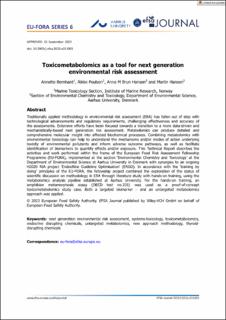| dc.contributor.author | Bernhard, Annette | |
| dc.contributor.author | Poulsen, Rikke | |
| dc.contributor.author | Hansen, Anna M. Brun | |
| dc.contributor.author | Hansen, Martin | |
| dc.date.accessioned | 2023-12-07T13:53:21Z | |
| dc.date.available | 2023-12-07T13:53:21Z | |
| dc.date.created | 2023-12-06T13:56:03Z | |
| dc.date.issued | 2023 | |
| dc.identifier.citation | EFSA Journal. 2023, . | |
| dc.identifier.issn | 1831-4732 | |
| dc.identifier.uri | https://hdl.handle.net/11250/3106448 | |
| dc.description.abstract | Traditionally applied methodology in environmental risk assessment (ERA) has fallen out of step with technological advancements and regulatory requirements, challenging effectiveness and accuracy of the assessments. Extensive efforts have been focused towards a transition to a more data-driven and mechanistically-based next generation risk assessment. Metabolomics can produce detailed and comprehensive molecular insight into affected biochemical processes. Combining metabolomics with environmental toxicology can help to understand the mechanisms and/or modes of action underlying toxicity of environmental pollutants and inform adverse outcome pathways, as well as facilitate identification of biomarkers to quantify effects and/or exposure. This Technical Report describes the activities and work performed within the frame of the European Food Risk Assessment Fellowship Programme (EU-FORA), implemented at the section ‘Environmental Chemistry and Toxicology’ at the Department of Environmental Science at Aarhus University in Denmark with synergies to an ongoing H2020 RIA project ‘EndocRine Guideline Optimisation’ (ERGO). In accordance with the ‘training by doing’ principles of the EU-FORA, the fellowship project combined the exploration of the status of scientific discussion on methodology in ERA through literature study with hands-on training, using the metabolomics analysis pipeline established at Aarhus University. For the hands-on training, an amphibian metamorphosis assay (OECD test no.231) was used as a proof-of-concept toxicometabolomics study case. Both a targeted biomarker – and an untargeted metabolomics approach was applied. | |
| dc.description.abstract | Toxicometabolomics as a tool for next generation environmental risk assessment | |
| dc.language.iso | eng | |
| dc.title | Toxicometabolomics as a tool for next generation environmental risk assessment | |
| dc.title.alternative | Toxicometabolomics as a tool for next generation environmental risk assessment | |
| dc.type | Peer reviewed | |
| dc.type | Journal article | |
| dc.description.version | publishedVersion | |
| dc.source.pagenumber | 12 | |
| dc.source.journal | EFSA Journal | |
| dc.identifier.doi | 10.2903/j.efsa.2023.e211005 | |
| dc.identifier.cristin | 2209862 | |
| dc.relation.project | Havforskningsinstituttet: 15881 | |
| cristin.ispublished | true | |
| cristin.fulltext | original | |
| cristin.qualitycode | 1 | |
